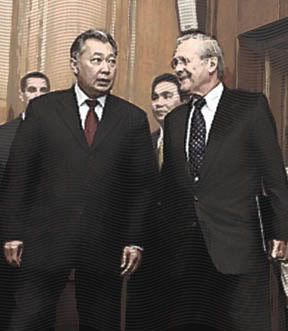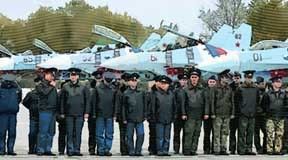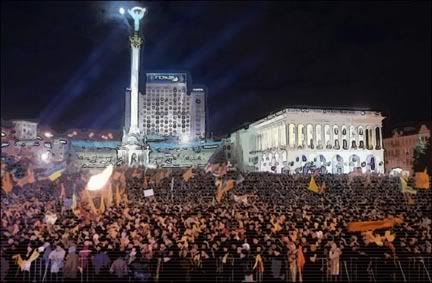Guerillas Without guns/Chapter VII
Posted 5/9/07
Following the ambiguous “Tulip Revolution” of March 2005, Kurmanbek Bakiev was confirmed the second President since independence with an election on July 10. He received an astounding 89% return of the vote (turnout 53%), partly based on his new political alliance with opposition leader Felix Kulov, released from prison with all charges dropped and soon appointed Prime Minister as agreed to before the election. Bakiyev was inaugurated on August 14, and the old parliament agreed to dissolve, and all seemed in order: another successful Color Revolution.
 |
One “legitimate” opposition leader that did make it into the new government, though he didn’t stay long, was Azimbek Beknazarov, whose 2002 jailing had led to the bloody protests that caused Bakiyev to resign as PM and join the opposition. President Bakiyev rewarded Beknazarov with the post of Prosecutor General, and IWPR explained that the new PG aggressively launched a series of investigations into corruption and criminal activity by Akayev era officials, including a former Central Electoral Commission chief, the head of the Kyrgyz National Bank, and former-PM Nikolai Tanaev. On September 19th, Beknazarov finally got parliament to strip the immunity normally accorded to one of its members - Aydar Akayev, recently-elected son of the ex-president – to allow corruption charges against him to proceed. Later on the same day, President Bakiev dismissed Beknazarov, officially for improper procedures in another investigation. [3]
Other powers behind Akayev’s ouster, like Bamayan Erkinbayev, a ‘controversial businessman’ [ie - mafia-connected] also took power. Once accused of being behind deadly gun battles over control of a local marketplace, Erkinbayev was also a popular politician who entertained presidential ambitions. But he stepped aside for the Bakiev-Kulov coalition, and reportedly helped to organize the southern ‘protests’ which eventually brought them to power. Afterwards he was rewarded with a seat in parliament and the chairmanship of the national Olympic Committee The BBC noted the wide concern that the new influence of “shady businessmen like Mr. Erkinbayev is one of the most worrying trends of the past year.” [4]
Erkinbayev was only in government a few months before he was killed by gunmen on September 22, in an incident widely attributed to his business dealings. [5] Worse, this was only one of at least seven leading and controversial politicians shot dead in various incidents between June 2005 and May 2006. Among them was new MP Tynychbek Akmatbayev, head of parliament’s Committee on Law Enforcement, but reportedly connected to organized crime and embroiled in a long-running feud with new PM Felix Kulov. During an October visit to a prison near Bishkek to calm an uprising there, Akmatbayev and his entourage were somehow engulfed by the rebellion and he was shot dead in the chaos. [6] There were rumors that Kulov had been involved in engineering Akmatbayev’s killing, as Byzantine as such a plot would have been.
After his bother’s death, Ryspek Akmatbayev’s, himself widely thought of as a major mafia kingpin, was asked if his family feud with Kulov could lead to bloodshed. Ryspek responded “nobody [else] needs to suffer […] I suggest that we meet man to man. I will kick his ass, and that will be that.” [7] And he was working his way up, in April 2006 winning a special election to represent his home district in parliament, [8] though he was unable to take up his seat immediately because of pending murder charges against him. [9] His election prompted international condemnation from the West and even Russia expressed concern about the possible “criminalization” of Kyrgyz politics. [10] That noise didn’t last long though - Ryspek himself was reportedly shot dead as he left a Bishkek Mosque on Wednesday May 10. Akmatbayev’s aides carried his body away before police could investigate. The city police chief told the media “I can see spent gun cartridges and blood, but no bodies.” [11]
On the political front, there was some improvement in the political and civil sphere, as noted in the west: Freedom House upgraded the country from “Not Free” to “Partly Free” in 2006 based on “the continuing permissive environment for the promotion of civil liberties and political rights.” They noted a “mixed” record, including increased media freedom and local elections in December 2005 went off “with only ‘rough irregularities.” [12] But despite these “positive steps forward,” the good news was far outweighed by the bad; continued financial hardships across the country fed a deepening sense of dispirited frustration, by BBC reports. [13] Of course the government remained upbeat and established a new national holiday marking the anniversary of the Tulip Revolution, which president Bakiyev described as “the triumph of justice.” To mark the first anniversary, the new government threw a nationwide party on March 24, but BBC News released an article explaining that the “so called” tulip revolution was in fact “no revolution:”
“Many residents of this poor Central Asia republic are still not in the mood for a party. ‘There was never a time in the history of Kyrgyzstan when the confidence of the people in their government was so low,’ said Edil Baisalov of the Bishkek-based NGO, the Coalition for Democracy and Civil Society. An international think tank, the International Crisis Group, has gone further, labeling the nation a ‘faltering state.’” [14]
From early on Bakiyev was supported by government-sponsored youth groups; RFE/RL reported in July 2005 on a youth team headquartered in Gorky Square, Central Bishkek. They operated from a yurt (a traditional nomadic tent) stocked with music equipment, national costumes, and T-shirts and baseball caps printed with slogans like “We are for Bakiev!” [15] Their support proved needed as the president’s popularity took a nose-dive in the wake of Beknazarov's dismissal and Erkinbayev's assassination. Bakiev’s approval rates reached their lowest point on September 24, when thousands of protesters took to the streets of Jalalabad to again demand a president’s resignation. [16] Hinting at the methods of the “Tulip Revolution,” another RFE/RL piece from November warned of “the frightening prospect of a rent-a-mob free-for-all” which could lead to many ends, “including an authoritarian drive to reestablish order.” [17]
The Tulip revolution was first lumped in with the Orange and Rose Revolutions, and taken as another victory for the West. But it didn’t work quite right – the protests weren’t properly done, all the bloodshed was discouraging, and the reforms have not come. It seems the West’s Tulip Revolution was hijacked from within via Erkinbayev et al, paid off by the new government first with the ballot then the bullet to wash its hands of once useful but now embarrassing criminal benefactors. There may well have been behind-the-scenes Akayev/Bakiyev deals to stage the president’s flight to Russia to complete the drama. I sense Russia’s or China’s complicity in this episode, and it certainly would serve their interest. It would allow the SCO leaders to publicly take yet another “hit” and exaggerate the perceived extent of the color revolution campaign. This would justify their own counter-measures – which would come within weeks - while causing no real lasting change. A SCO-planned upheaval would preempt any real pro-West color revolution, as it were preventing a forest fire with a controlled burn.
---
Next: The SCO Holdouts: Kazakhstan, Tajikistan
Sources:
[1]





